Business Resources: Recruitment, Finance, and Operations Report
VerifiedAdded on 2020/06/04
|10
|3748
|83
Report
AI Summary
This report provides a comprehensive analysis of business resources, focusing on the case study of Asda. It begins by examining recruitment documentation, employability skills, and the required resources for operations. The report then delves into financial resources, covering internal and external sources of finance, and interpreting financial statements like the profit and loss account and balance sheet. Furthermore, it illustrates the use of budgets for financial control and evaluates the financial state of a given business, using Asda's financial performance as an example. The report incorporates key concepts like job descriptions, person specifications, employability skills, financial resources, and budgeting techniques, making it a valuable resource for understanding business operations and financial management.
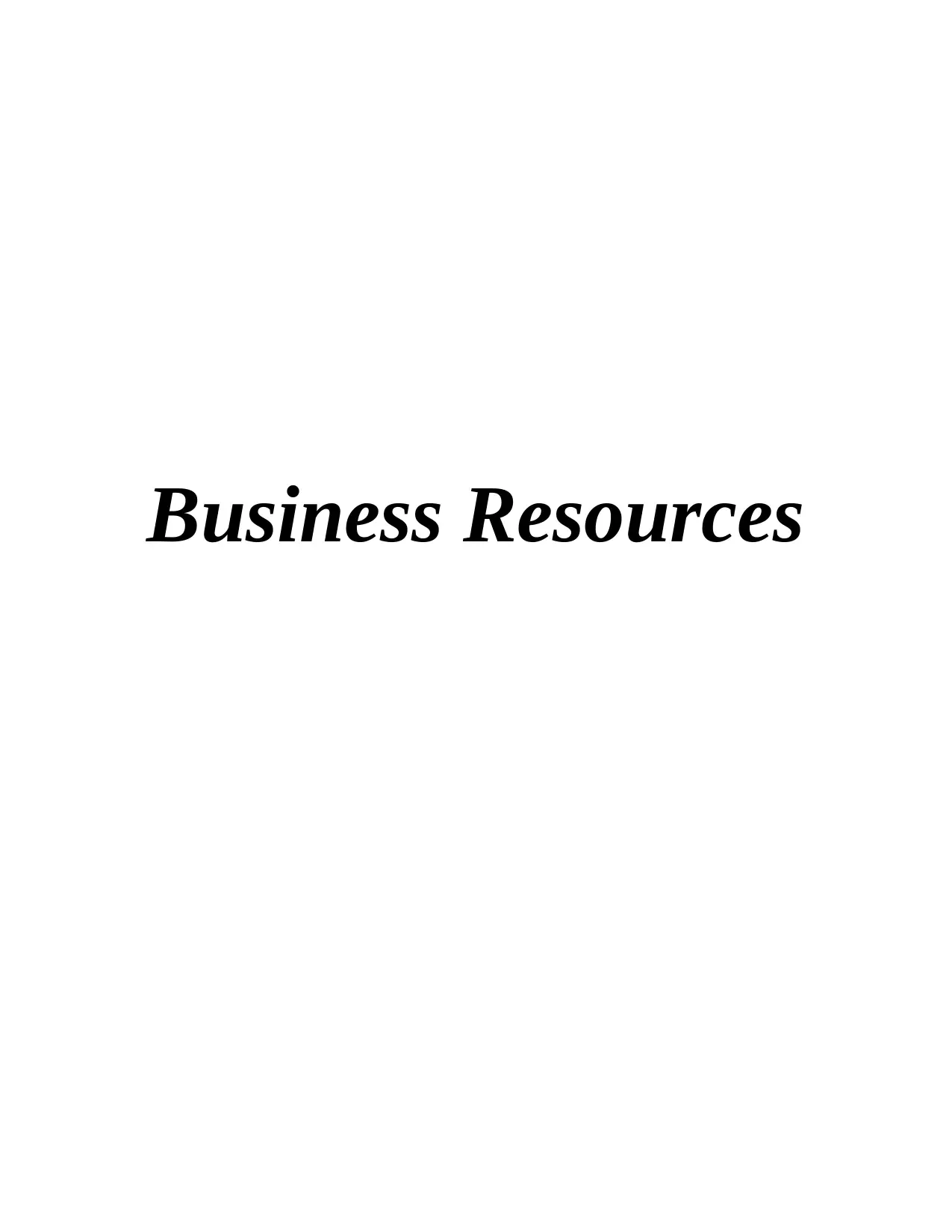
Business Resources
P
1
D
e
s
c
r
i
b
P
1
D
e
s
c
r
i
b
P
1
D
e
s
c
r
i
b
P
1
D
e
s
c
r
i
b
Paraphrase This Document
Need a fresh take? Get an instant paraphrase of this document with our AI Paraphraser
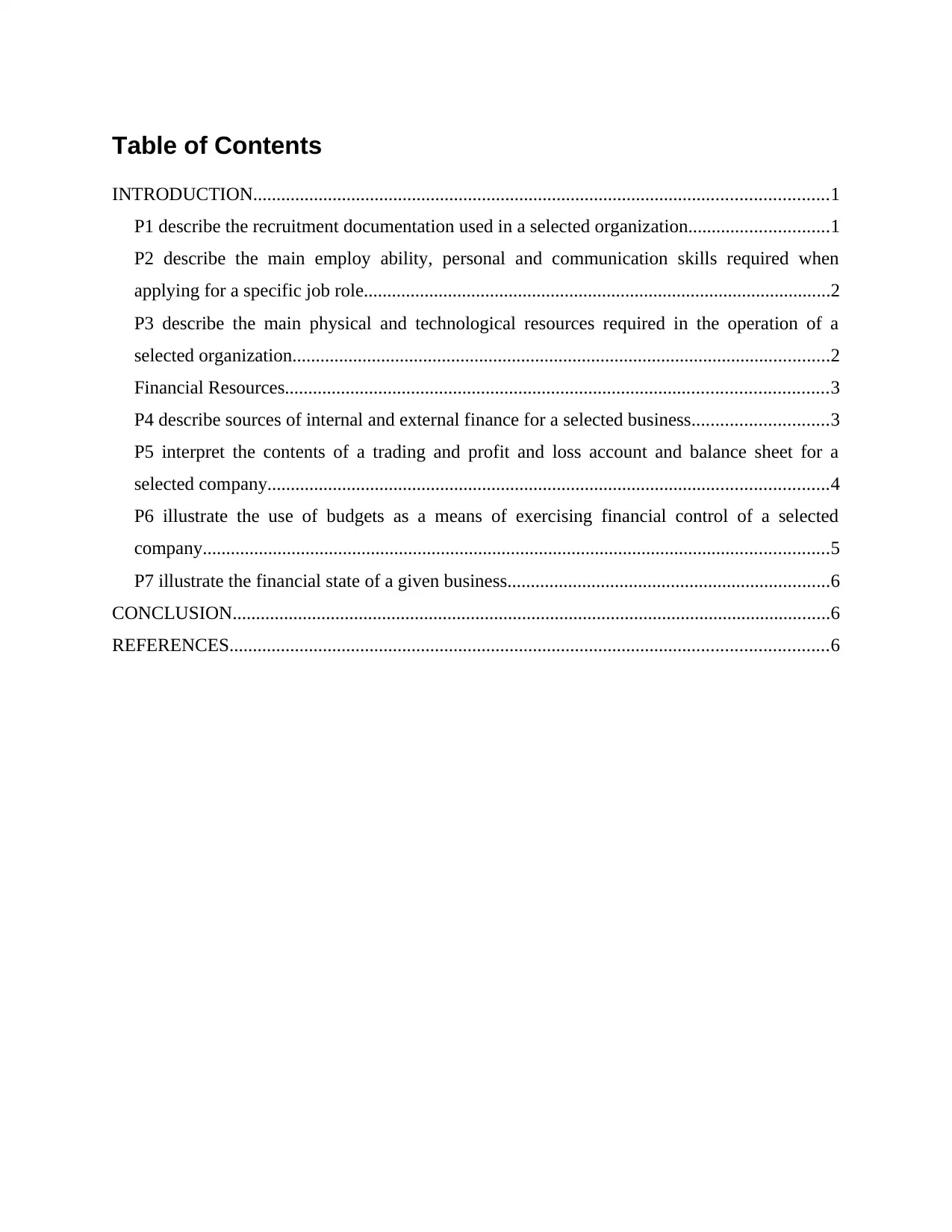
Table of Contents
INTRODUCTION...........................................................................................................................1
P1 describe the recruitment documentation used in a selected organization..............................1
P2 describe the main employ ability, personal and communication skills required when
applying for a specific job role....................................................................................................2
P3 describe the main physical and technological resources required in the operation of a
selected organization...................................................................................................................2
Financial Resources....................................................................................................................3
P4 describe sources of internal and external finance for a selected business.............................3
P5 interpret the contents of a trading and profit and loss account and balance sheet for a
selected company........................................................................................................................4
P6 illustrate the use of budgets as a means of exercising financial control of a selected
company......................................................................................................................................5
P7 illustrate the financial state of a given business.....................................................................6
CONCLUSION................................................................................................................................6
REFERENCES................................................................................................................................6
INTRODUCTION...........................................................................................................................1
P1 describe the recruitment documentation used in a selected organization..............................1
P2 describe the main employ ability, personal and communication skills required when
applying for a specific job role....................................................................................................2
P3 describe the main physical and technological resources required in the operation of a
selected organization...................................................................................................................2
Financial Resources....................................................................................................................3
P4 describe sources of internal and external finance for a selected business.............................3
P5 interpret the contents of a trading and profit and loss account and balance sheet for a
selected company........................................................................................................................4
P6 illustrate the use of budgets as a means of exercising financial control of a selected
company......................................................................................................................................5
P7 illustrate the financial state of a given business.....................................................................6
CONCLUSION................................................................................................................................6
REFERENCES................................................................................................................................6
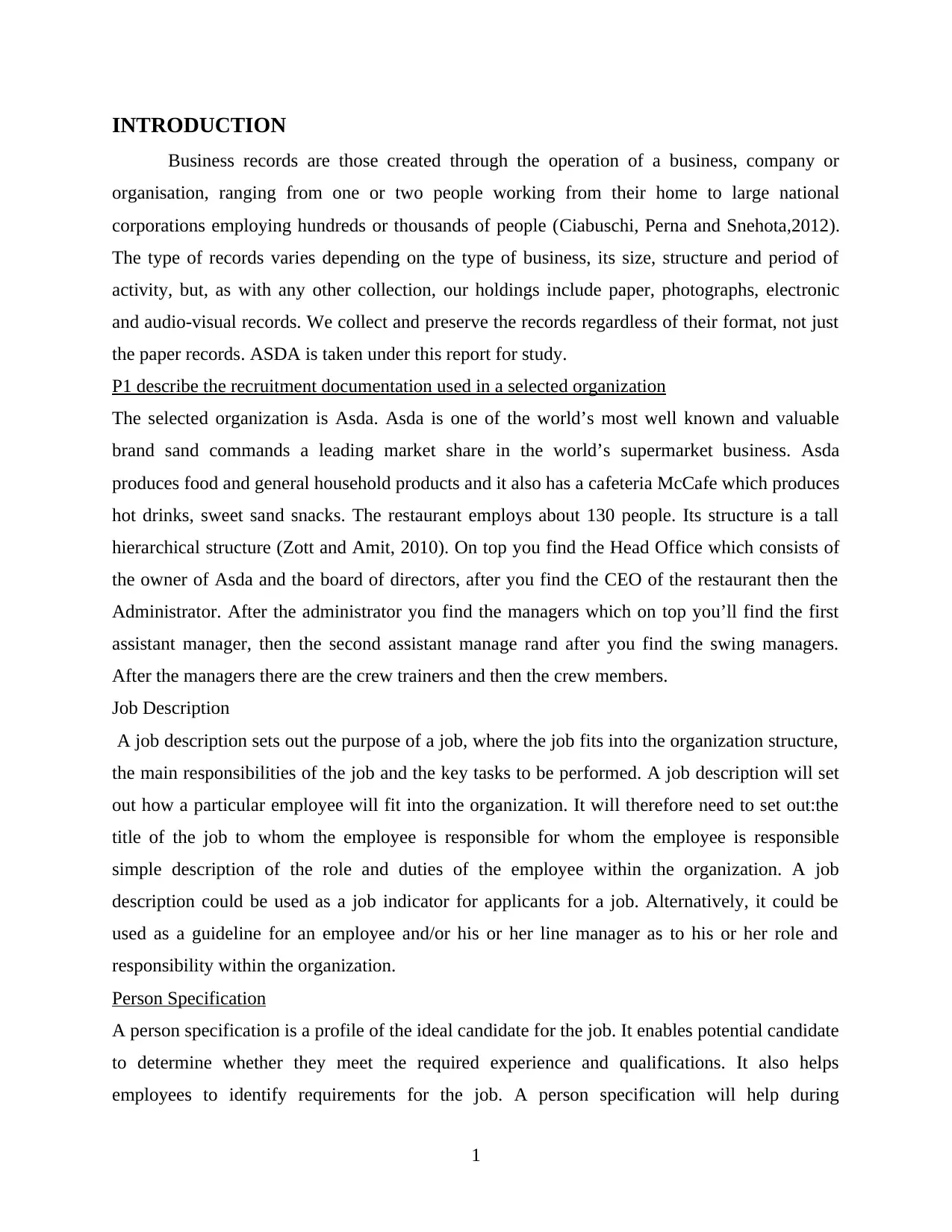
INTRODUCTION
Business records are those created through the operation of a business, company or
organisation, ranging from one or two people working from their home to large national
corporations employing hundreds or thousands of people (Ciabuschi, Perna and Snehota,2012).
The type of records varies depending on the type of business, its size, structure and period of
activity, but, as with any other collection, our holdings include paper, photographs, electronic
and audio-visual records. We collect and preserve the records regardless of their format, not just
the paper records. ASDA is taken under this report for study.
P1 describe the recruitment documentation used in a selected organization
The selected organization is Asda. Asda is one of the world’s most well known and valuable
brand sand commands a leading market share in the world’s supermarket business. Asda
produces food and general household products and it also has a cafeteria McCafe which produces
hot drinks, sweet sand snacks. The restaurant employs about 130 people. Its structure is a tall
hierarchical structure (Zott and Amit, 2010). On top you find the Head Office which consists of
the owner of Asda and the board of directors, after you find the CEO of the restaurant then the
Administrator. After the administrator you find the managers which on top you’ll find the first
assistant manager, then the second assistant manage rand after you find the swing managers.
After the managers there are the crew trainers and then the crew members.
Job Description
A job description sets out the purpose of a job, where the job fits into the organization structure,
the main responsibilities of the job and the key tasks to be performed. A job description will set
out how a particular employee will fit into the organization. It will therefore need to set out:the
title of the job to whom the employee is responsible for whom the employee is responsible
simple description of the role and duties of the employee within the organization. A job
description could be used as a job indicator for applicants for a job. Alternatively, it could be
used as a guideline for an employee and/or his or her line manager as to his or her role and
responsibility within the organization.
Person Specification
A person specification is a profile of the ideal candidate for the job. It enables potential candidate
to determine whether they meet the required experience and qualifications. It also helps
employees to identify requirements for the job. A person specification will help during
1
Business records are those created through the operation of a business, company or
organisation, ranging from one or two people working from their home to large national
corporations employing hundreds or thousands of people (Ciabuschi, Perna and Snehota,2012).
The type of records varies depending on the type of business, its size, structure and period of
activity, but, as with any other collection, our holdings include paper, photographs, electronic
and audio-visual records. We collect and preserve the records regardless of their format, not just
the paper records. ASDA is taken under this report for study.
P1 describe the recruitment documentation used in a selected organization
The selected organization is Asda. Asda is one of the world’s most well known and valuable
brand sand commands a leading market share in the world’s supermarket business. Asda
produces food and general household products and it also has a cafeteria McCafe which produces
hot drinks, sweet sand snacks. The restaurant employs about 130 people. Its structure is a tall
hierarchical structure (Zott and Amit, 2010). On top you find the Head Office which consists of
the owner of Asda and the board of directors, after you find the CEO of the restaurant then the
Administrator. After the administrator you find the managers which on top you’ll find the first
assistant manager, then the second assistant manage rand after you find the swing managers.
After the managers there are the crew trainers and then the crew members.
Job Description
A job description sets out the purpose of a job, where the job fits into the organization structure,
the main responsibilities of the job and the key tasks to be performed. A job description will set
out how a particular employee will fit into the organization. It will therefore need to set out:the
title of the job to whom the employee is responsible for whom the employee is responsible
simple description of the role and duties of the employee within the organization. A job
description could be used as a job indicator for applicants for a job. Alternatively, it could be
used as a guideline for an employee and/or his or her line manager as to his or her role and
responsibility within the organization.
Person Specification
A person specification is a profile of the ideal candidate for the job. It enables potential candidate
to determine whether they meet the required experience and qualifications. It also helps
employees to identify requirements for the job. A person specification will help during
1
⊘ This is a preview!⊘
Do you want full access?
Subscribe today to unlock all pages.

Trusted by 1+ million students worldwide
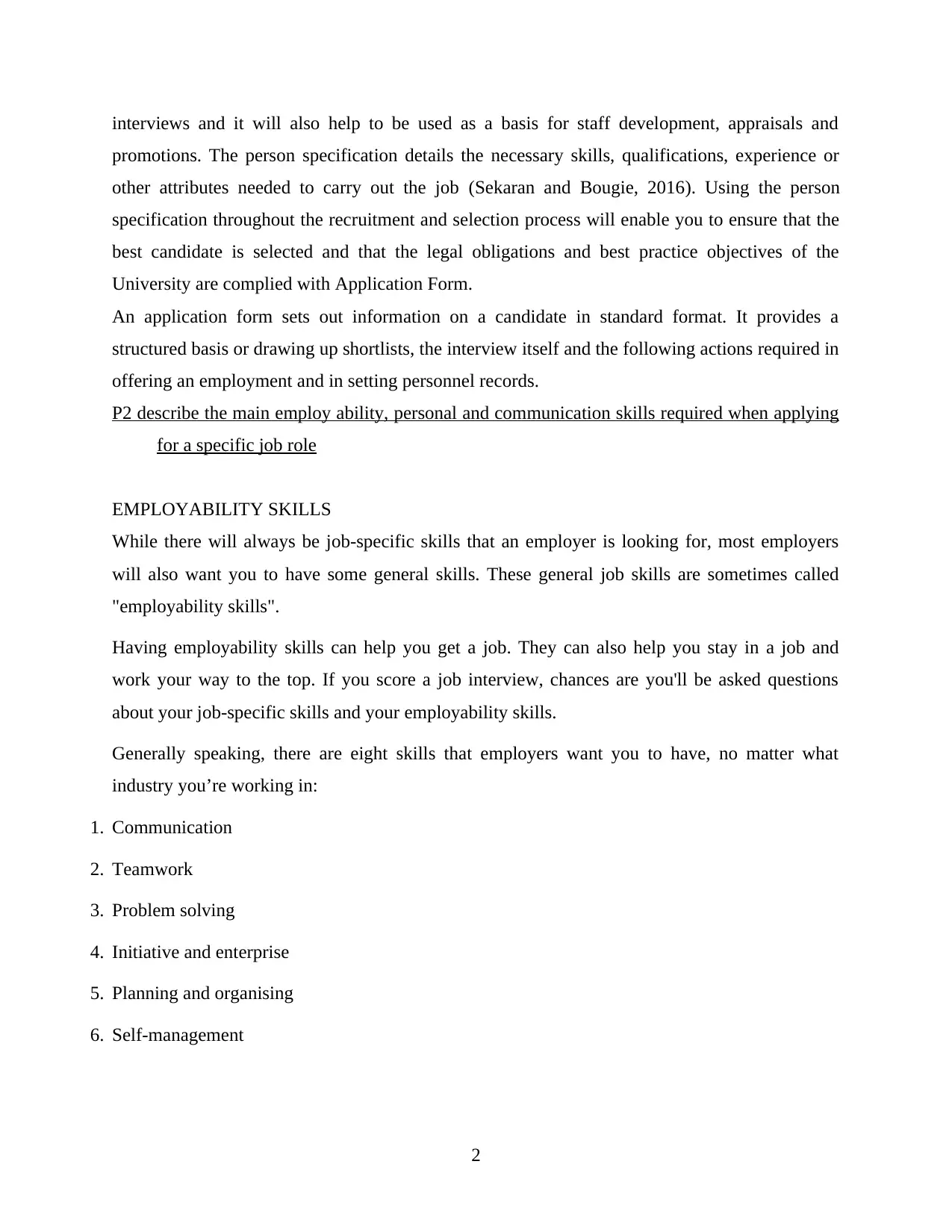
interviews and it will also help to be used as a basis for staff development, appraisals and
promotions. The person specification details the necessary skills, qualifications, experience or
other attributes needed to carry out the job (Sekaran and Bougie, 2016). Using the person
specification throughout the recruitment and selection process will enable you to ensure that the
best candidate is selected and that the legal obligations and best practice objectives of the
University are complied with Application Form.
An application form sets out information on a candidate in standard format. It provides a
structured basis or drawing up shortlists, the interview itself and the following actions required in
offering an employment and in setting personnel records.
P2 describe the main employ ability, personal and communication skills required when applying
for a specific job role
EMPLOYABILITY SKILLS
While there will always be job-specific skills that an employer is looking for, most employers
will also want you to have some general skills. These general job skills are sometimes called
"employability skills".
Having employability skills can help you get a job. They can also help you stay in a job and
work your way to the top. If you score a job interview, chances are you'll be asked questions
about your job-specific skills and your employability skills.
Generally speaking, there are eight skills that employers want you to have, no matter what
industry you’re working in:
1. Communication
2. Teamwork
3. Problem solving
4. Initiative and enterprise
5. Planning and organising
6. Self-management
2
promotions. The person specification details the necessary skills, qualifications, experience or
other attributes needed to carry out the job (Sekaran and Bougie, 2016). Using the person
specification throughout the recruitment and selection process will enable you to ensure that the
best candidate is selected and that the legal obligations and best practice objectives of the
University are complied with Application Form.
An application form sets out information on a candidate in standard format. It provides a
structured basis or drawing up shortlists, the interview itself and the following actions required in
offering an employment and in setting personnel records.
P2 describe the main employ ability, personal and communication skills required when applying
for a specific job role
EMPLOYABILITY SKILLS
While there will always be job-specific skills that an employer is looking for, most employers
will also want you to have some general skills. These general job skills are sometimes called
"employability skills".
Having employability skills can help you get a job. They can also help you stay in a job and
work your way to the top. If you score a job interview, chances are you'll be asked questions
about your job-specific skills and your employability skills.
Generally speaking, there are eight skills that employers want you to have, no matter what
industry you’re working in:
1. Communication
2. Teamwork
3. Problem solving
4. Initiative and enterprise
5. Planning and organising
6. Self-management
2
Paraphrase This Document
Need a fresh take? Get an instant paraphrase of this document with our AI Paraphraser
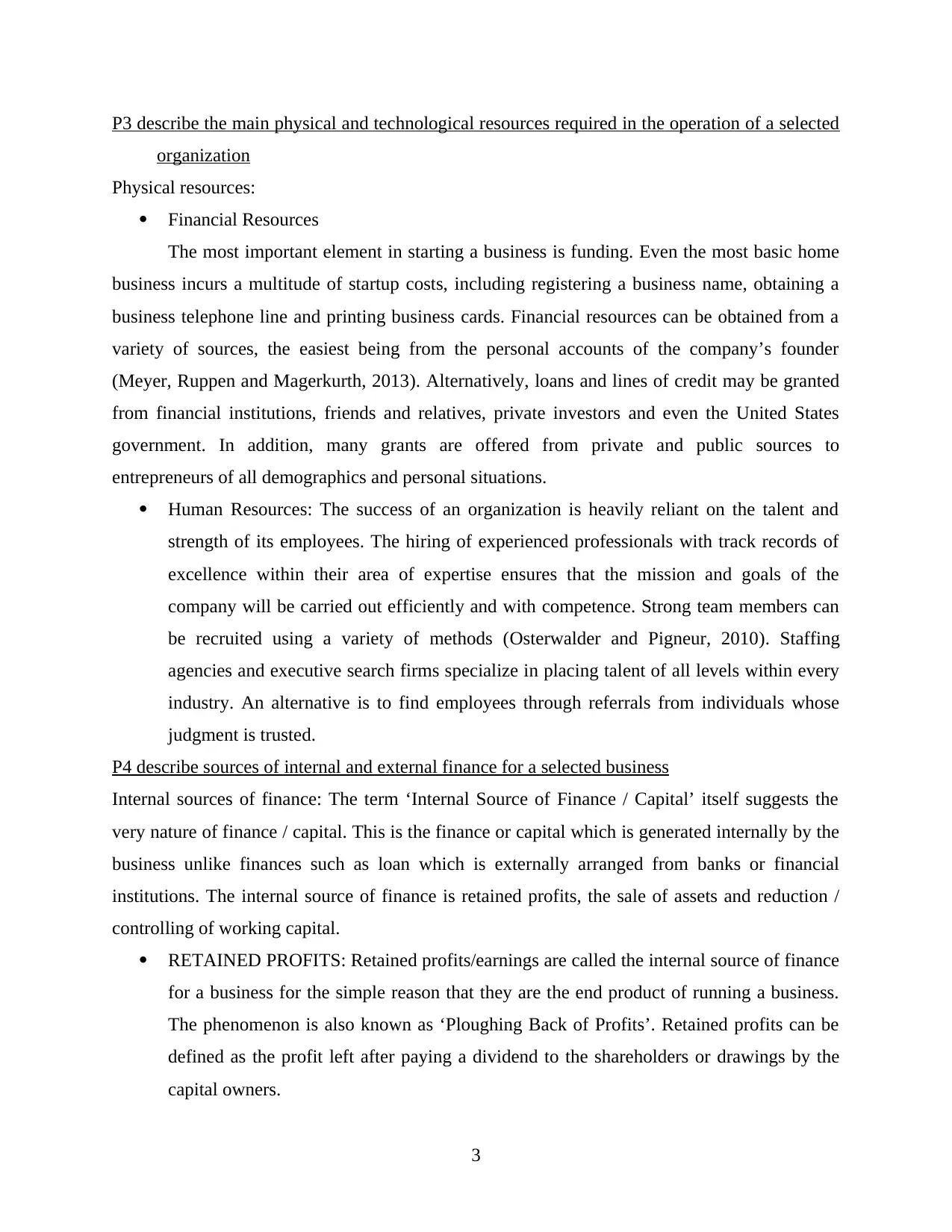
P3 describe the main physical and technological resources required in the operation of a selected
organization
Physical resources:
Financial Resources
The most important element in starting a business is funding. Even the most basic home
business incurs a multitude of startup costs, including registering a business name, obtaining a
business telephone line and printing business cards. Financial resources can be obtained from a
variety of sources, the easiest being from the personal accounts of the company’s founder
(Meyer, Ruppen and Magerkurth, 2013). Alternatively, loans and lines of credit may be granted
from financial institutions, friends and relatives, private investors and even the United States
government. In addition, many grants are offered from private and public sources to
entrepreneurs of all demographics and personal situations.
Human Resources: The success of an organization is heavily reliant on the talent and
strength of its employees. The hiring of experienced professionals with track records of
excellence within their area of expertise ensures that the mission and goals of the
company will be carried out efficiently and with competence. Strong team members can
be recruited using a variety of methods (Osterwalder and Pigneur, 2010). Staffing
agencies and executive search firms specialize in placing talent of all levels within every
industry. An alternative is to find employees through referrals from individuals whose
judgment is trusted.
P4 describe sources of internal and external finance for a selected business
Internal sources of finance: The term ‘Internal Source of Finance / Capital’ itself suggests the
very nature of finance / capital. This is the finance or capital which is generated internally by the
business unlike finances such as loan which is externally arranged from banks or financial
institutions. The internal source of finance is retained profits, the sale of assets and reduction /
controlling of working capital.
RETAINED PROFITS: Retained profits/earnings are called the internal source of finance
for a business for the simple reason that they are the end product of running a business.
The phenomenon is also known as ‘Ploughing Back of Profits’. Retained profits can be
defined as the profit left after paying a dividend to the shareholders or drawings by the
capital owners.
3
organization
Physical resources:
Financial Resources
The most important element in starting a business is funding. Even the most basic home
business incurs a multitude of startup costs, including registering a business name, obtaining a
business telephone line and printing business cards. Financial resources can be obtained from a
variety of sources, the easiest being from the personal accounts of the company’s founder
(Meyer, Ruppen and Magerkurth, 2013). Alternatively, loans and lines of credit may be granted
from financial institutions, friends and relatives, private investors and even the United States
government. In addition, many grants are offered from private and public sources to
entrepreneurs of all demographics and personal situations.
Human Resources: The success of an organization is heavily reliant on the talent and
strength of its employees. The hiring of experienced professionals with track records of
excellence within their area of expertise ensures that the mission and goals of the
company will be carried out efficiently and with competence. Strong team members can
be recruited using a variety of methods (Osterwalder and Pigneur, 2010). Staffing
agencies and executive search firms specialize in placing talent of all levels within every
industry. An alternative is to find employees through referrals from individuals whose
judgment is trusted.
P4 describe sources of internal and external finance for a selected business
Internal sources of finance: The term ‘Internal Source of Finance / Capital’ itself suggests the
very nature of finance / capital. This is the finance or capital which is generated internally by the
business unlike finances such as loan which is externally arranged from banks or financial
institutions. The internal source of finance is retained profits, the sale of assets and reduction /
controlling of working capital.
RETAINED PROFITS: Retained profits/earnings are called the internal source of finance
for a business for the simple reason that they are the end product of running a business.
The phenomenon is also known as ‘Ploughing Back of Profits’. Retained profits can be
defined as the profit left after paying a dividend to the shareholders or drawings by the
capital owners.
3
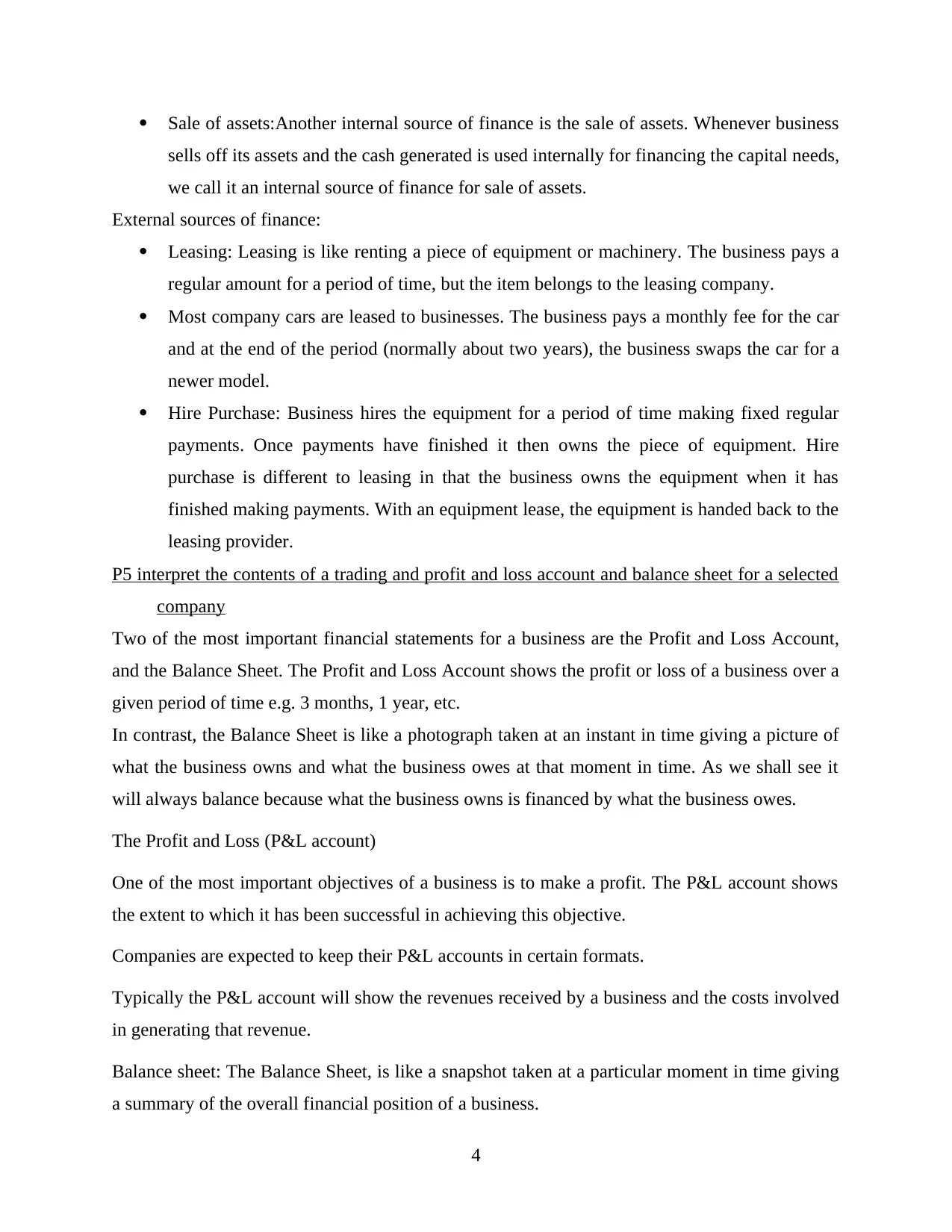
Sale of assets:Another internal source of finance is the sale of assets. Whenever business
sells off its assets and the cash generated is used internally for financing the capital needs,
we call it an internal source of finance for sale of assets.
External sources of finance:
Leasing: Leasing is like renting a piece of equipment or machinery. The business pays a
regular amount for a period of time, but the item belongs to the leasing company.
Most company cars are leased to businesses. The business pays a monthly fee for the car
and at the end of the period (normally about two years), the business swaps the car for a
newer model.
Hire Purchase: Business hires the equipment for a period of time making fixed regular
payments. Once payments have finished it then owns the piece of equipment. Hire
purchase is different to leasing in that the business owns the equipment when it has
finished making payments. With an equipment lease, the equipment is handed back to the
leasing provider.
P5 interpret the contents of a trading and profit and loss account and balance sheet for a selected
company
Two of the most important financial statements for a business are the Profit and Loss Account,
and the Balance Sheet. The Profit and Loss Account shows the profit or loss of a business over a
given period of time e.g. 3 months, 1 year, etc.
In contrast, the Balance Sheet is like a photograph taken at an instant in time giving a picture of
what the business owns and what the business owes at that moment in time. As we shall see it
will always balance because what the business owns is financed by what the business owes.
The Profit and Loss (P&L account)
One of the most important objectives of a business is to make a profit. The P&L account shows
the extent to which it has been successful in achieving this objective.
Companies are expected to keep their P&L accounts in certain formats.
Typically the P&L account will show the revenues received by a business and the costs involved
in generating that revenue.
Balance sheet: The Balance Sheet, is like a snapshot taken at a particular moment in time giving
a summary of the overall financial position of a business.
4
sells off its assets and the cash generated is used internally for financing the capital needs,
we call it an internal source of finance for sale of assets.
External sources of finance:
Leasing: Leasing is like renting a piece of equipment or machinery. The business pays a
regular amount for a period of time, but the item belongs to the leasing company.
Most company cars are leased to businesses. The business pays a monthly fee for the car
and at the end of the period (normally about two years), the business swaps the car for a
newer model.
Hire Purchase: Business hires the equipment for a period of time making fixed regular
payments. Once payments have finished it then owns the piece of equipment. Hire
purchase is different to leasing in that the business owns the equipment when it has
finished making payments. With an equipment lease, the equipment is handed back to the
leasing provider.
P5 interpret the contents of a trading and profit and loss account and balance sheet for a selected
company
Two of the most important financial statements for a business are the Profit and Loss Account,
and the Balance Sheet. The Profit and Loss Account shows the profit or loss of a business over a
given period of time e.g. 3 months, 1 year, etc.
In contrast, the Balance Sheet is like a photograph taken at an instant in time giving a picture of
what the business owns and what the business owes at that moment in time. As we shall see it
will always balance because what the business owns is financed by what the business owes.
The Profit and Loss (P&L account)
One of the most important objectives of a business is to make a profit. The P&L account shows
the extent to which it has been successful in achieving this objective.
Companies are expected to keep their P&L accounts in certain formats.
Typically the P&L account will show the revenues received by a business and the costs involved
in generating that revenue.
Balance sheet: The Balance Sheet, is like a snapshot taken at a particular moment in time giving
a summary of the overall financial position of a business.
4
⊘ This is a preview!⊘
Do you want full access?
Subscribe today to unlock all pages.

Trusted by 1+ million students worldwide
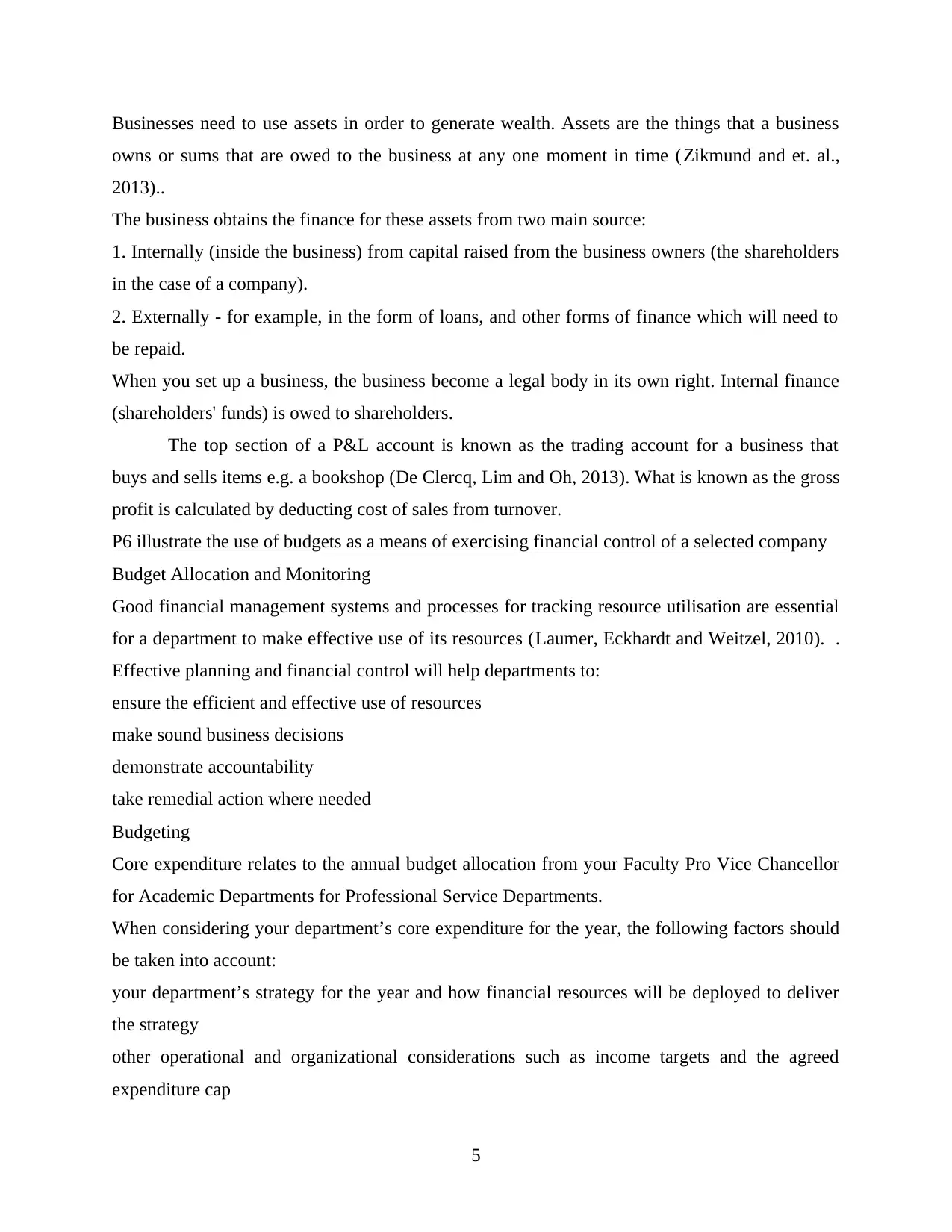
Businesses need to use assets in order to generate wealth. Assets are the things that a business
owns or sums that are owed to the business at any one moment in time (Zikmund and et. al.,
2013)..
The business obtains the finance for these assets from two main source:
1. Internally (inside the business) from capital raised from the business owners (the shareholders
in the case of a company).
2. Externally - for example, in the form of loans, and other forms of finance which will need to
be repaid.
When you set up a business, the business become a legal body in its own right. Internal finance
(shareholders' funds) is owed to shareholders.
The top section of a P&L account is known as the trading account for a business that
buys and sells items e.g. a bookshop (De Clercq, Lim and Oh, 2013). What is known as the gross
profit is calculated by deducting cost of sales from turnover.
P6 illustrate the use of budgets as a means of exercising financial control of a selected company
Budget Allocation and Monitoring
Good financial management systems and processes for tracking resource utilisation are essential
for a department to make effective use of its resources (Laumer, Eckhardt and Weitzel, 2010). .
Effective planning and financial control will help departments to:
ensure the efficient and effective use of resources
make sound business decisions
demonstrate accountability
take remedial action where needed
Budgeting
Core expenditure relates to the annual budget allocation from your Faculty Pro Vice Chancellor
for Academic Departments for Professional Service Departments.
When considering your department’s core expenditure for the year, the following factors should
be taken into account:
your department’s strategy for the year and how financial resources will be deployed to deliver
the strategy
other operational and organizational considerations such as income targets and the agreed
expenditure cap
5
owns or sums that are owed to the business at any one moment in time (Zikmund and et. al.,
2013)..
The business obtains the finance for these assets from two main source:
1. Internally (inside the business) from capital raised from the business owners (the shareholders
in the case of a company).
2. Externally - for example, in the form of loans, and other forms of finance which will need to
be repaid.
When you set up a business, the business become a legal body in its own right. Internal finance
(shareholders' funds) is owed to shareholders.
The top section of a P&L account is known as the trading account for a business that
buys and sells items e.g. a bookshop (De Clercq, Lim and Oh, 2013). What is known as the gross
profit is calculated by deducting cost of sales from turnover.
P6 illustrate the use of budgets as a means of exercising financial control of a selected company
Budget Allocation and Monitoring
Good financial management systems and processes for tracking resource utilisation are essential
for a department to make effective use of its resources (Laumer, Eckhardt and Weitzel, 2010). .
Effective planning and financial control will help departments to:
ensure the efficient and effective use of resources
make sound business decisions
demonstrate accountability
take remedial action where needed
Budgeting
Core expenditure relates to the annual budget allocation from your Faculty Pro Vice Chancellor
for Academic Departments for Professional Service Departments.
When considering your department’s core expenditure for the year, the following factors should
be taken into account:
your department’s strategy for the year and how financial resources will be deployed to deliver
the strategy
other operational and organizational considerations such as income targets and the agreed
expenditure cap
5
Paraphrase This Document
Need a fresh take? Get an instant paraphrase of this document with our AI Paraphraser
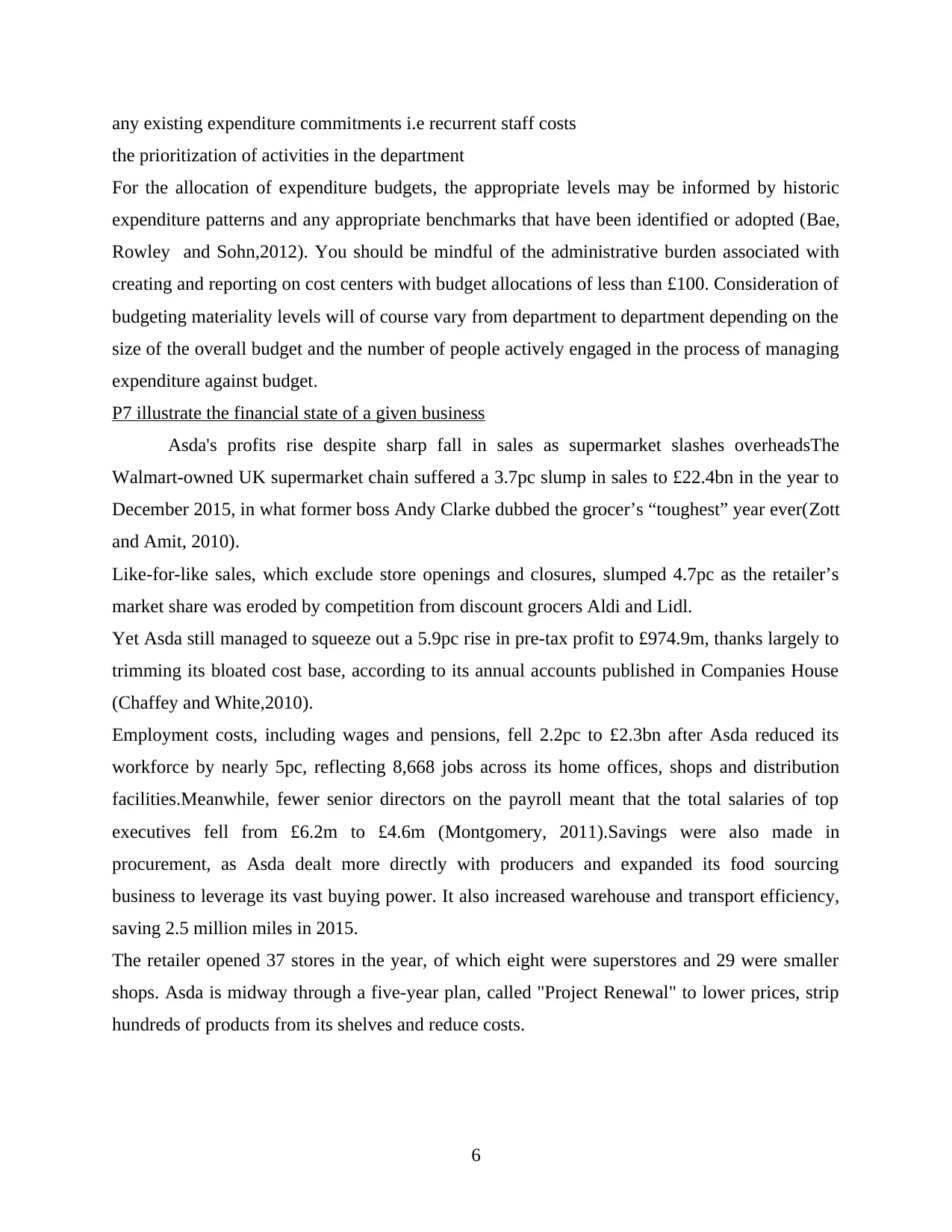
any existing expenditure commitments i.e recurrent staff costs
the prioritization of activities in the department
For the allocation of expenditure budgets, the appropriate levels may be informed by historic
expenditure patterns and any appropriate benchmarks that have been identified or adopted (Bae,
Rowley and Sohn,2012). You should be mindful of the administrative burden associated with
creating and reporting on cost centers with budget allocations of less than £100. Consideration of
budgeting materiality levels will of course vary from department to department depending on the
size of the overall budget and the number of people actively engaged in the process of managing
expenditure against budget.
P7 illustrate the financial state of a given business
Asda's profits rise despite sharp fall in sales as supermarket slashes overheadsThe
Walmart-owned UK supermarket chain suffered a 3.7pc slump in sales to £22.4bn in the year to
December 2015, in what former boss Andy Clarke dubbed the grocer’s “toughest” year ever(Zott
and Amit, 2010).
Like-for-like sales, which exclude store openings and closures, slumped 4.7pc as the retailer’s
market share was eroded by competition from discount grocers Aldi and Lidl.
Yet Asda still managed to squeeze out a 5.9pc rise in pre-tax profit to £974.9m, thanks largely to
trimming its bloated cost base, according to its annual accounts published in Companies House
(Chaffey and White,2010).
Employment costs, including wages and pensions, fell 2.2pc to £2.3bn after Asda reduced its
workforce by nearly 5pc, reflecting 8,668 jobs across its home offices, shops and distribution
facilities.Meanwhile, fewer senior directors on the payroll meant that the total salaries of top
executives fell from £6.2m to £4.6m (Montgomery, 2011).Savings were also made in
procurement, as Asda dealt more directly with producers and expanded its food sourcing
business to leverage its vast buying power. It also increased warehouse and transport efficiency,
saving 2.5 million miles in 2015.
The retailer opened 37 stores in the year, of which eight were superstores and 29 were smaller
shops. Asda is midway through a five-year plan, called "Project Renewal" to lower prices, strip
hundreds of products from its shelves and reduce costs.
6
the prioritization of activities in the department
For the allocation of expenditure budgets, the appropriate levels may be informed by historic
expenditure patterns and any appropriate benchmarks that have been identified or adopted (Bae,
Rowley and Sohn,2012). You should be mindful of the administrative burden associated with
creating and reporting on cost centers with budget allocations of less than £100. Consideration of
budgeting materiality levels will of course vary from department to department depending on the
size of the overall budget and the number of people actively engaged in the process of managing
expenditure against budget.
P7 illustrate the financial state of a given business
Asda's profits rise despite sharp fall in sales as supermarket slashes overheadsThe
Walmart-owned UK supermarket chain suffered a 3.7pc slump in sales to £22.4bn in the year to
December 2015, in what former boss Andy Clarke dubbed the grocer’s “toughest” year ever(Zott
and Amit, 2010).
Like-for-like sales, which exclude store openings and closures, slumped 4.7pc as the retailer’s
market share was eroded by competition from discount grocers Aldi and Lidl.
Yet Asda still managed to squeeze out a 5.9pc rise in pre-tax profit to £974.9m, thanks largely to
trimming its bloated cost base, according to its annual accounts published in Companies House
(Chaffey and White,2010).
Employment costs, including wages and pensions, fell 2.2pc to £2.3bn after Asda reduced its
workforce by nearly 5pc, reflecting 8,668 jobs across its home offices, shops and distribution
facilities.Meanwhile, fewer senior directors on the payroll meant that the total salaries of top
executives fell from £6.2m to £4.6m (Montgomery, 2011).Savings were also made in
procurement, as Asda dealt more directly with producers and expanded its food sourcing
business to leverage its vast buying power. It also increased warehouse and transport efficiency,
saving 2.5 million miles in 2015.
The retailer opened 37 stores in the year, of which eight were superstores and 29 were smaller
shops. Asda is midway through a five-year plan, called "Project Renewal" to lower prices, strip
hundreds of products from its shelves and reduce costs.
6
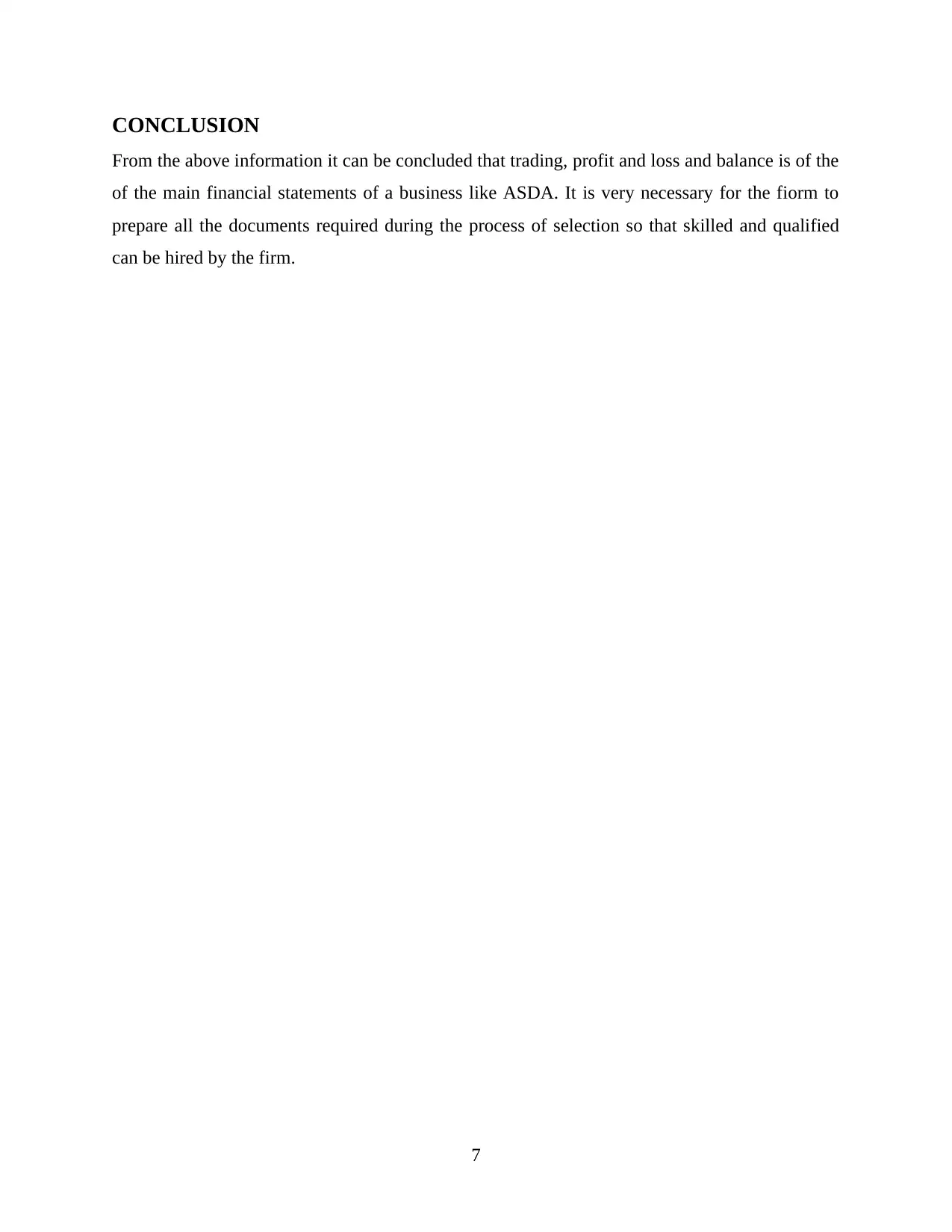
CONCLUSION
From the above information it can be concluded that trading, profit and loss and balance is of the
of the main financial statements of a business like ASDA. It is very necessary for the fiorm to
prepare all the documents required during the process of selection so that skilled and qualified
can be hired by the firm.
7
From the above information it can be concluded that trading, profit and loss and balance is of the
of the main financial statements of a business like ASDA. It is very necessary for the fiorm to
prepare all the documents required during the process of selection so that skilled and qualified
can be hired by the firm.
7
⊘ This is a preview!⊘
Do you want full access?
Subscribe today to unlock all pages.

Trusted by 1+ million students worldwide
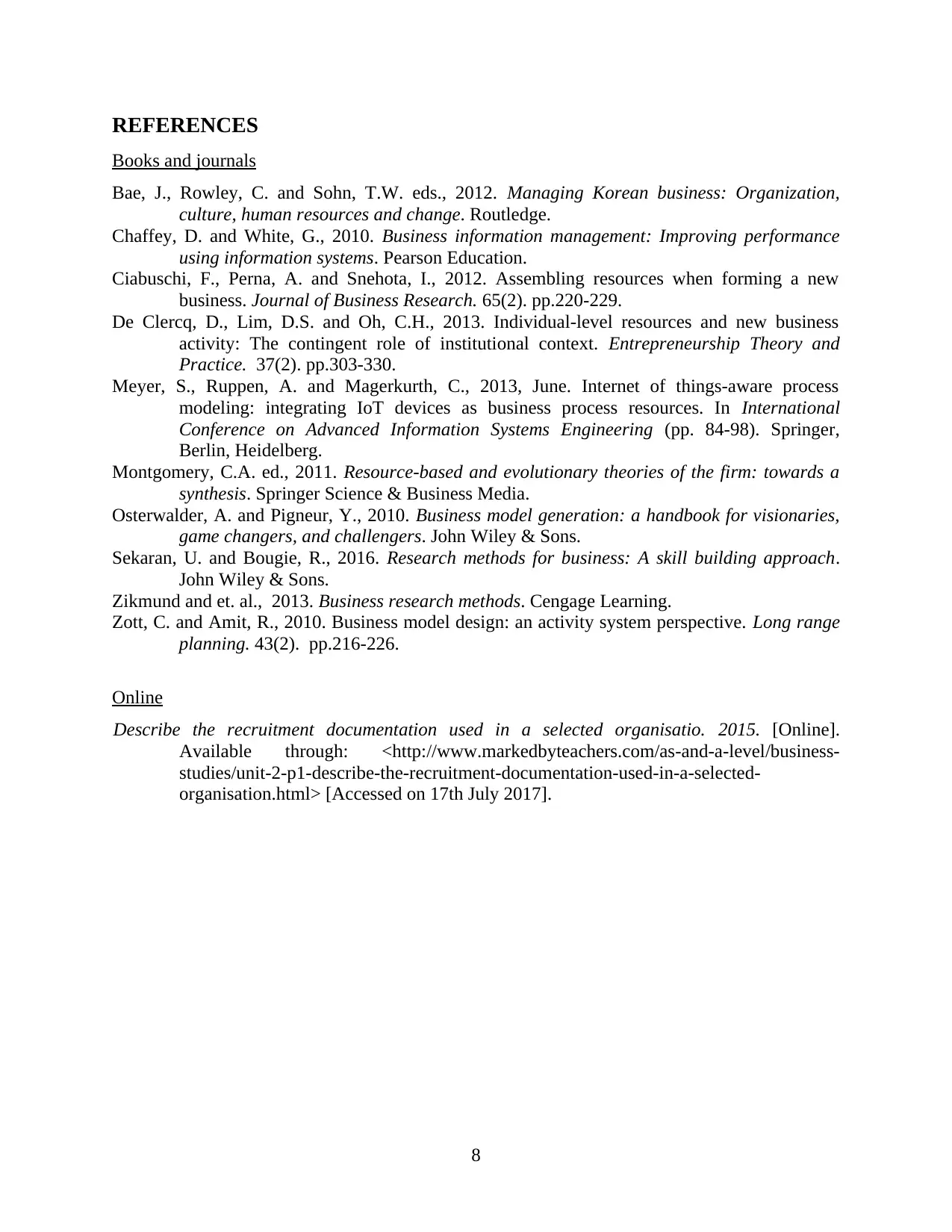
REFERENCES
Books and journals
Bae, J., Rowley, C. and Sohn, T.W. eds., 2012. Managing Korean business: Organization,
culture, human resources and change. Routledge.
Chaffey, D. and White, G., 2010. Business information management: Improving performance
using information systems. Pearson Education.
Ciabuschi, F., Perna, A. and Snehota, I., 2012. Assembling resources when forming a new
business. Journal of Business Research. 65(2). pp.220-229.
De Clercq, D., Lim, D.S. and Oh, C.H., 2013. Individual‐level resources and new business
activity: The contingent role of institutional context. Entrepreneurship Theory and
Practice. 37(2). pp.303-330.
Meyer, S., Ruppen, A. and Magerkurth, C., 2013, June. Internet of things-aware process
modeling: integrating IoT devices as business process resources. In International
Conference on Advanced Information Systems Engineering (pp. 84-98). Springer,
Berlin, Heidelberg.
Montgomery, C.A. ed., 2011. Resource-based and evolutionary theories of the firm: towards a
synthesis. Springer Science & Business Media.
Osterwalder, A. and Pigneur, Y., 2010. Business model generation: a handbook for visionaries,
game changers, and challengers. John Wiley & Sons.
Sekaran, U. and Bougie, R., 2016. Research methods for business: A skill building approach.
John Wiley & Sons.
Zikmund and et. al., 2013. Business research methods. Cengage Learning.
Zott, C. and Amit, R., 2010. Business model design: an activity system perspective. Long range
planning. 43(2). pp.216-226.
Online
Describe the recruitment documentation used in a selected organisatio. 2015. [Online].
Available through: <http://www.markedbyteachers.com/as-and-a-level/business-
studies/unit-2-p1-describe-the-recruitment-documentation-used-in-a-selected-
organisation.html> [Accessed on 17th July 2017].
8
Books and journals
Bae, J., Rowley, C. and Sohn, T.W. eds., 2012. Managing Korean business: Organization,
culture, human resources and change. Routledge.
Chaffey, D. and White, G., 2010. Business information management: Improving performance
using information systems. Pearson Education.
Ciabuschi, F., Perna, A. and Snehota, I., 2012. Assembling resources when forming a new
business. Journal of Business Research. 65(2). pp.220-229.
De Clercq, D., Lim, D.S. and Oh, C.H., 2013. Individual‐level resources and new business
activity: The contingent role of institutional context. Entrepreneurship Theory and
Practice. 37(2). pp.303-330.
Meyer, S., Ruppen, A. and Magerkurth, C., 2013, June. Internet of things-aware process
modeling: integrating IoT devices as business process resources. In International
Conference on Advanced Information Systems Engineering (pp. 84-98). Springer,
Berlin, Heidelberg.
Montgomery, C.A. ed., 2011. Resource-based and evolutionary theories of the firm: towards a
synthesis. Springer Science & Business Media.
Osterwalder, A. and Pigneur, Y., 2010. Business model generation: a handbook for visionaries,
game changers, and challengers. John Wiley & Sons.
Sekaran, U. and Bougie, R., 2016. Research methods for business: A skill building approach.
John Wiley & Sons.
Zikmund and et. al., 2013. Business research methods. Cengage Learning.
Zott, C. and Amit, R., 2010. Business model design: an activity system perspective. Long range
planning. 43(2). pp.216-226.
Online
Describe the recruitment documentation used in a selected organisatio. 2015. [Online].
Available through: <http://www.markedbyteachers.com/as-and-a-level/business-
studies/unit-2-p1-describe-the-recruitment-documentation-used-in-a-selected-
organisation.html> [Accessed on 17th July 2017].
8
1 out of 10
Related Documents
Your All-in-One AI-Powered Toolkit for Academic Success.
+13062052269
info@desklib.com
Available 24*7 on WhatsApp / Email
![[object Object]](/_next/static/media/star-bottom.7253800d.svg)
Unlock your academic potential
Copyright © 2020–2025 A2Z Services. All Rights Reserved. Developed and managed by ZUCOL.





